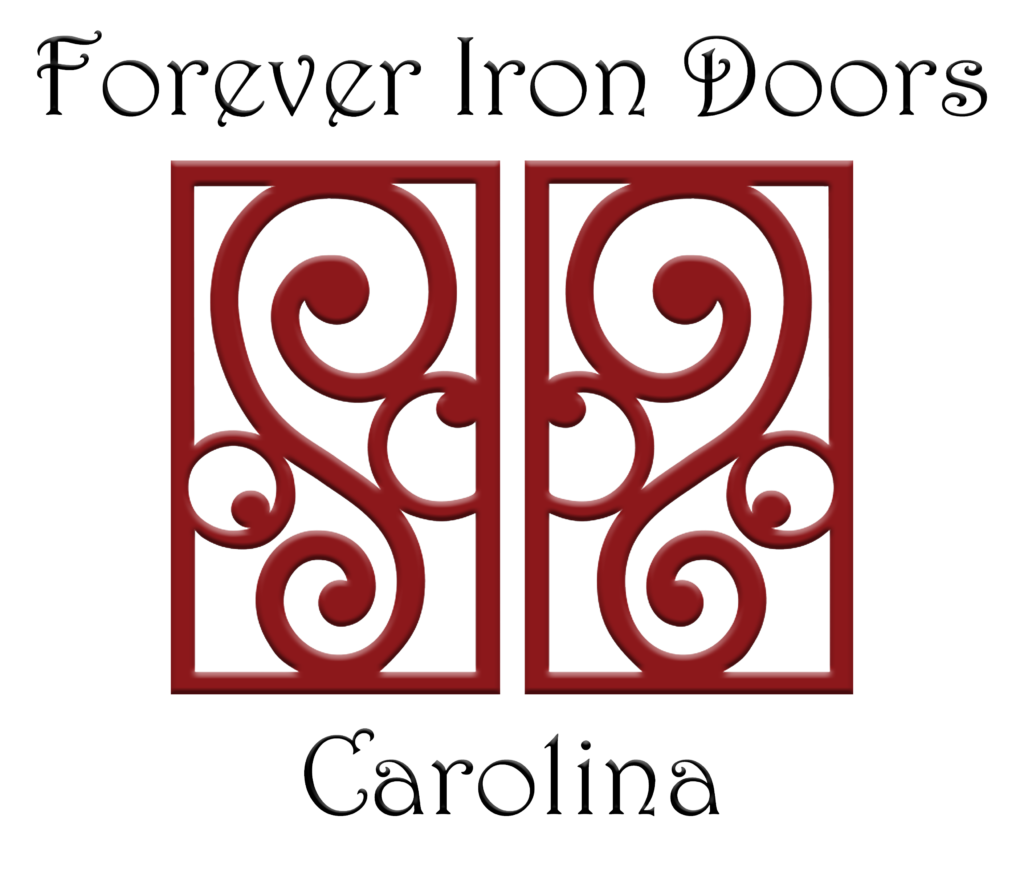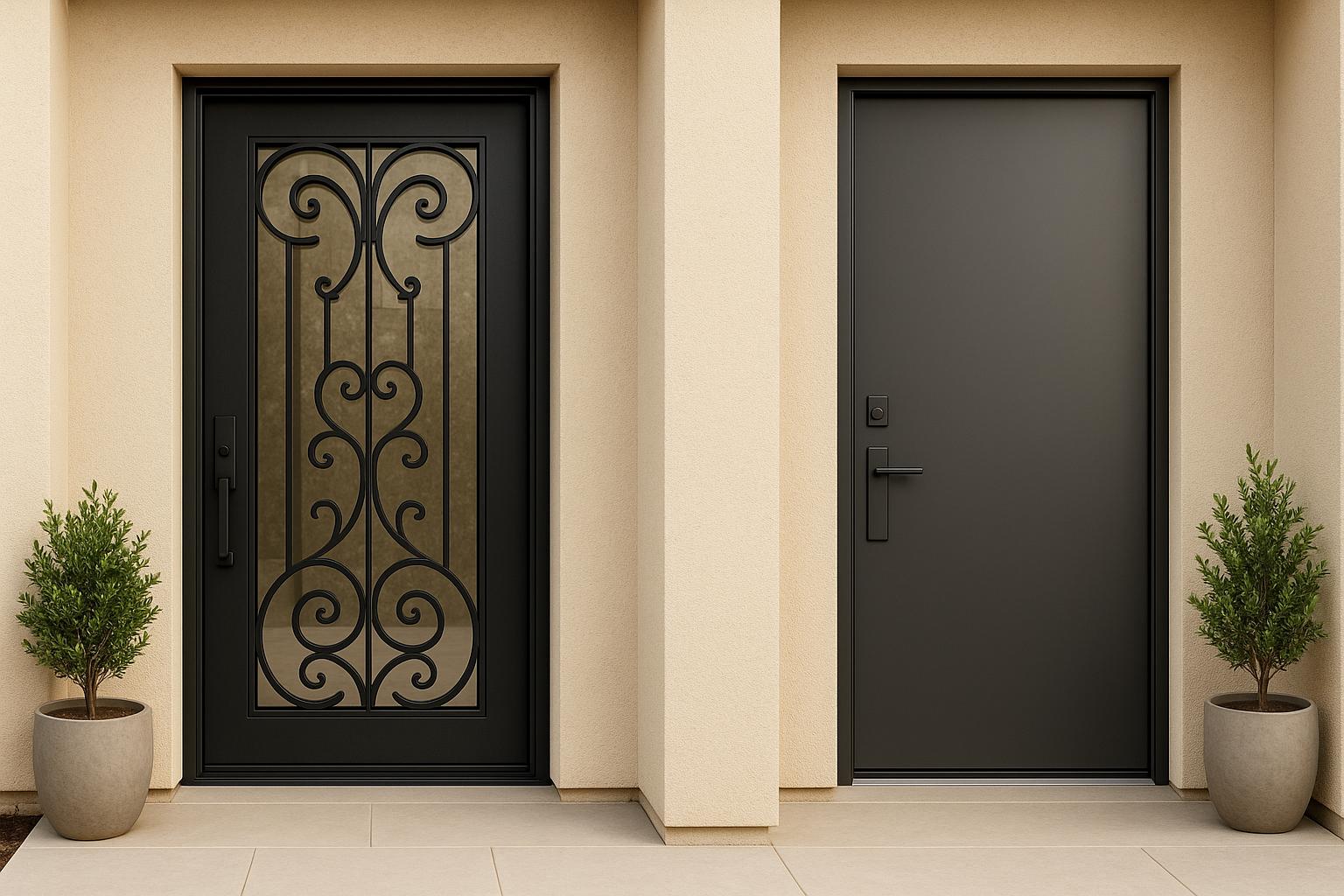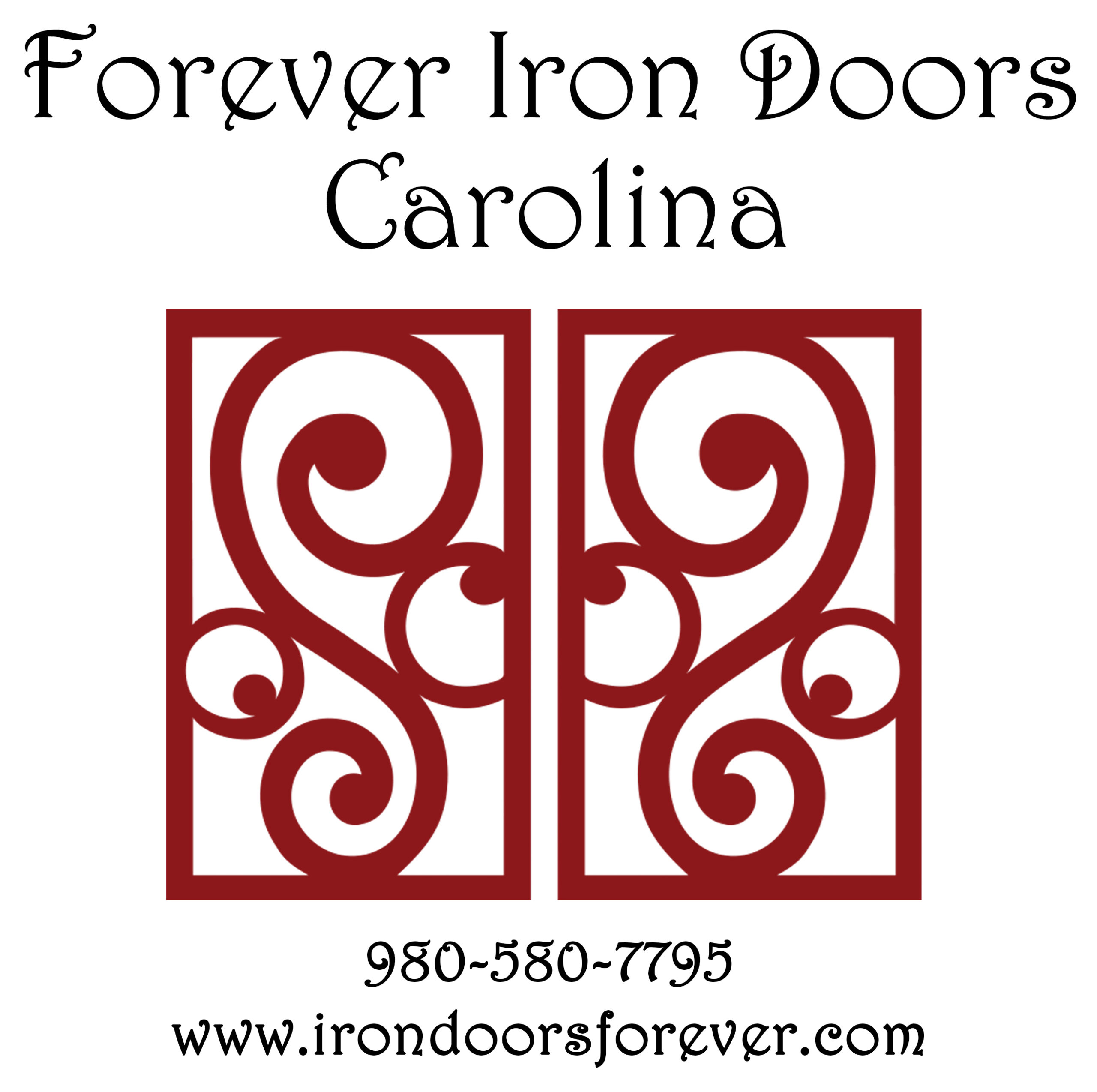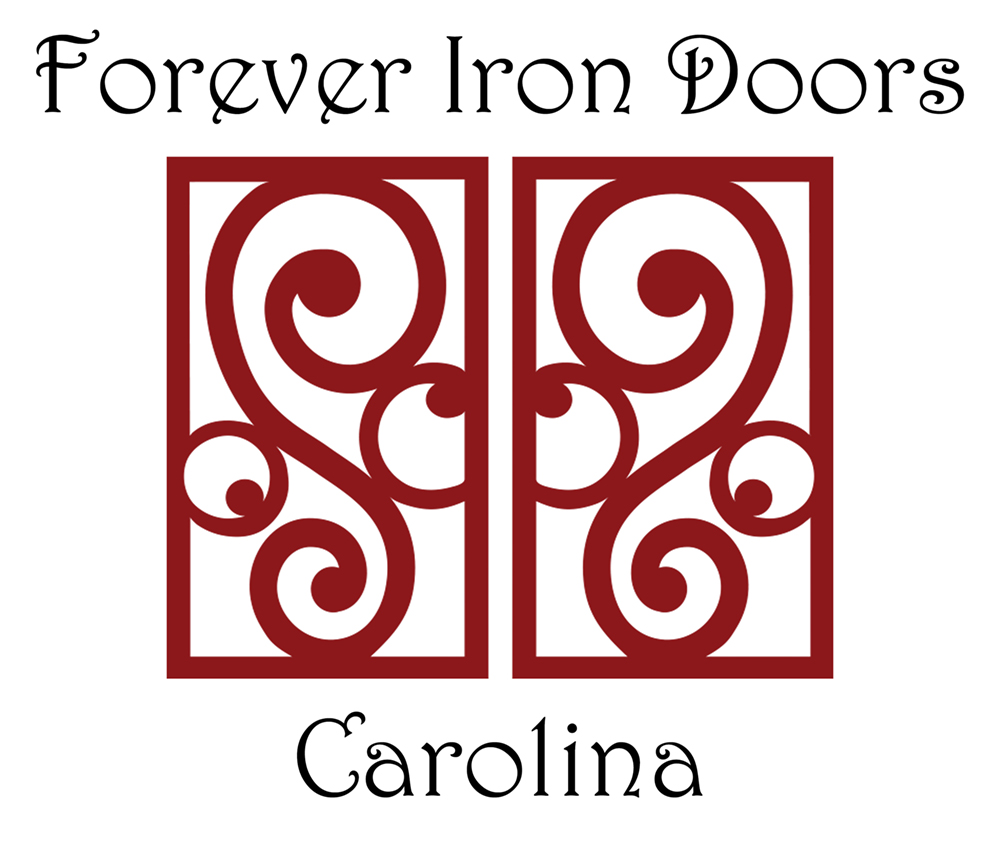Choosing between iron and steel doors depends on your priorities. Here’s a quick breakdown to help you decide:
- Iron doors: Known for durability, bold designs, and long lifespan (30–50+ years). They’re perfect for homes needing a standout aesthetic and enhanced security. However, they are more expensive, starting at $2,000 and requiring periodic maintenance to prevent rust.
- Steel doors: Affordable (starting at $200), strong, and energy-efficient. They last 30–50 years with minimal upkeep but may dent or rust without proper care. Best for modern homes or budget-conscious buyers.
Quick Comparison
| Feature | Iron Doors | Steel Doors |
|---|---|---|
| Material | Raw iron, hand-forged | Iron-carbon alloy |
| Design | Ornate, custom options | Sleek, simple styles |
| Price Range | $2,000–$10,000+ | $200–$1,000 |
| Lifespan | 30–50+ years | 30–50 years |
| Maintenance | Low with rust prevention | Requires weatherproofing |
| Rust Resistance | High with care | Moderate |
Bottom line: Choose iron for luxury and timeless design or steel for affordability and practicality.
Iron Doors
Iron doors bring a blend of artistry and durability to home entryways, making them a popular choice for those who want a standout feature. Crafted from materials like cast iron or wrought iron, these doors offer a unique combination of style, security, and longevity. For homeowners looking to make a bold statement, iron doors deliver both elegance and functionality.
Custom Design Options
One of the standout features of wrought iron is its flexibility in design. Its malleable nature allows for intricate patterns, detailed scrollwork, and artistic touches that can reflect your personal taste and complement your home’s aesthetic. Whether you want to include a family crest, specific motifs, or elaborate decorative accents, iron doors can bring any vision to life. The design process for custom iron doors is a collaborative effort between the homeowner and the craftsman, ensuring every detail aligns with your preferences. From classic European-inspired designs to sleek, modern geometric patterns, this adaptability makes iron doors a sought-after choice for luxury and historic homes alike. Beyond their beauty, these doors are built to stand the test of time.
How Long Iron Doors Last
When properly cared for, iron doors can last for decades. Their longevity is a testament to the material’s strength and resistance to wear under normal conditions. Even doors installed many years ago often remain functional and visually appealing. Regular maintenance is key – this includes cleaning, checking for rust, and applying protective sealants to prevent oxidation. Homes in coastal or humid areas may need extra attention due to environmental factors. For a detailed guide on upkeep, homeowners can consult resources on how to clean iron doors.
Security and Visual Appeal
Iron doors are not just visually striking – they’re also incredibly secure. The heavy, dense construction of iron provides a strong deterrent against break-ins, giving homeowners peace of mind. At the same time, their ornate designs and commanding presence elevate a home’s exterior, often boosting property value. Much like a wrought iron gate enhances a property’s worth, iron doors serve as architectural focal points, particularly in upscale or traditional neighborhoods. Their combination of security, elegance, and lasting appeal sets them apart from other materials like steel.
Steel Doors
Steel doors are a go-to choice for homeowners seeking durability, security, and affordability. Made from galvanized steel, these doors have gained traction in modern home designs thanks to their strength, low maintenance needs, and cost-effectiveness. Unlike the intricate detailing often found in iron doors, steel doors focus on practicality and contemporary security.
Strength and Cost Advantages
Steel doors are built to provide top-tier security. In fact, they can resist forced entry up to five times better than traditional wooden doors, offering homeowners peace of mind and potential savings through insurance discounts.
The financial perks don’t stop there. Installing steel doors can offer a high return on investment, with up to 90% of the cost recouped when selling a property. Additionally, many insurance companies acknowledge the added security by offering discounts of 5% to 15% on policies.
Beyond security, steel doors are energy-efficient. Proper insulation in these doors helps maintain indoor temperatures better than standard doors, potentially saving homeowners $30 to $50 per month on energy bills. This combination of security, energy savings, and affordability makes steel doors a smart, long-term investment.
Easy Maintenance and Longevity
One of the standout features of steel doors is how little upkeep they require. Unlike wooden doors that demand frequent staining or painting, steel doors resist common issues like warping, cracking, and rotting. Megan Powell from Toulmin Windows & Doors highlights this durability:
"Steel doors are known for their strength and durability, which makes them an excellent investment for homeowners who want a long-lasting door."
With regular inspections, steel doors can last over 30 years. However, it’s important to check for dents or damage to their protective coating, as exposed areas can rust, particularly in humid or coastal climates.
Design Limitations
While steel doors excel in function, their design options are somewhat limited. They often come in standard styles, with fewer choices for intricate patterns or decorative details. This industrial look may not appeal to those seeking a more ornate aesthetic. That said, modern trends have introduced sleek, contemporary designs that embrace the industrial vibe.
Steel doors can complement a wide range of architectural styles, including cottage, arts & crafts, classic, colonial, contemporary, and country homes. Finishes like matte black, pewter, copper, or bronze can add a stylish touch. For homes that prioritize clean lines and a modern feel, steel doors are an excellent fit.
Iron vs Steel Door Comparison
Choosing between iron and steel doors comes down to understanding their distinct characteristics. Both materials have their strengths, but they vary in construction, appearance, and long-term practicality.
Material and Construction:
Iron doors are crafted from raw iron ore, often hand-forged into intricate designs. Steel doors, on the other hand, are made from an iron-carbon alloy, precision-manufactured for consistency and durability. This difference in composition impacts their strength, longevity, and design versatility.
Aesthetic Appeal:
Iron doors are known for their detailed, hand-forged artistry, making them ideal for those who appreciate traditional or custom designs. Steel doors, however, lean toward a modern, minimalist aesthetic and are available in a range of shapes, sizes, and colors to suit contemporary preferences.
| Feature | Iron Doors | Steel Doors |
|---|---|---|
| Material | Raw iron ore, hand-forged | Iron-carbon alloy, precision-made |
| Design Style | Ornate, traditional, custom scrollwork | Sleek, minimalist, clean lines |
| Customization | Highly detailed, bespoke finishes | Variety of colors, textures, shapes |
| Price Range | $2,000 – $10,000+ | $200 – $1,000 |
| Lifespan | 30–50+ years | 30–50 years |
| Maintenance | Low with protective patina | Requires regular coatings/repainting |
| Rust Resistance | High with maintenance | Moderate, needs weatherproofing |
These features highlight the unique strengths of each material, but performance factors like security and durability are just as important.
Security and Durability:
Both iron and steel doors are built for strength. Iron doors provide excellent tensile strength combined with flexibility, while steel doors are known for their raw strength, though they can be more brittle. With proper upkeep, both types can last over 30 years.
Cost Considerations:
Steel doors are a budget-friendly option, typically priced between $200 and $1,000. Iron doors, with their custom designs and craftsmanship, range from $2,000 to over $10,000. While steel doors may require periodic weatherproofing and repainting, iron doors generally need less maintenance thanks to their natural patina.
Climate is another key factor to think about when deciding between these two options.
Weather Resistance:
Iron doors develop a protective patina over time, making them highly resistant to corrosion. Steel doors, however, are more prone to rust, especially in humid or coastal environments, and require regular weatherproofing to maintain their condition. For homes in areas with high humidity or salty air, iron doors are often the better choice.
Whether you prioritize the elegance and longevity of iron or the affordability and modern style of steel, understanding these differences will help you select the door that best matches your home’s needs and aesthetic.
sbb-itb-cd90297
How to Choose Between Iron and Steel Doors
Deciding between iron and steel doors comes down to balancing your budget, long-term value, and the overall aesthetic of your home. It’s also essential to think about how your local climate and maintenance requirements will affect your choice. Let’s break it down further to help you make the right decision.
Cost and Long-Term Value
Iron doors typically start at around $3,000 for budget-friendly options, while custom designs can easily surpass $5,000, and premium high-end options may cost over $10,000 when factoring in design, hardware, and installation. Steel doors, on the other hand, are generally more affordable.
When considering the long-term costs, think about structural durability and upkeep. Iron doors often require periodic maintenance, but they can significantly boost curb appeal – potentially increasing a home’s sale price by up to 7%. For instance, a $3,500 upgrade could yield an additional $11,718 in resale value. If upfront affordability is your top priority, steel doors might make more sense. However, if you’re looking for lasting durability, enhanced security, and a touch of elegance, wrought iron doors are worth the investment.
Ultimately, weigh the initial savings of steel against the long-term benefits of iron to find the best fit for your needs. And remember, your door’s design should also match your home’s aesthetic.
Style Preferences and Home Type
Your home’s architectural style plays a big role in your decision. Steel doors are a natural choice for modern and contemporary homes, with their sleek lines and large windows. They also pair well with Scandinavian, transitional, or even Cape Cod–style homes when kept simple.
Wrought iron doors, on the other hand, offer a timeless charm that’s perfect for traditional styles such as Mediterranean, Tudor, or Craftsman homes [29, 30]. Their intricate designs can enhance the character of these architectural styles in a way that steel often cannot.
If you’re looking for something truly personalized, consider going the custom route. Custom doors can be tailored to your home’s unique design needs. You can explore more about the custom iron door design process here.
Weather Conditions and Upkeep
Beyond cost and style, your local climate and maintenance requirements are crucial factors. Wrought iron doors are built to withstand harsh weather conditions but do require regular cleaning, occasional touch-ups, and hinge lubrication to prevent rust [31, 32, 33].
Steel doors, while durable, need consistent weatherproofing in humid or coastal areas to avoid rusting. Protective measures like galvanizing or powder coating can help, but any chipped paint or rust spots should be addressed quickly – either with touch-ups or professional restoration techniques like media blasting [31, 33].
For specific tips on keeping your iron doors in top shape, check out our guide on how to clean iron doors.
Conclusion
Deciding between iron and steel doors comes down to your specific needs and priorities.
Iron doors stand out for their durability, security, and intricate handcrafted designs, making them a timeless choice for traditional homes. With proper care, they can last over 60 years and provide excellent resistance to forced entry. However, they do require regular maintenance to prevent rust.
Steel doors, on the other hand, offer a sleek, modern aesthetic at a more affordable price. They usually last between 30 and 50 years and can provide up to a 98% return on investment. While steel doors are practical, they are more prone to dents and rust over time.
For homeowners focused on security, iron doors offer unmatched protection. Meanwhile, those prioritizing cost-effectiveness may lean toward steel. It’s also worth considering your local weather conditions – while both materials benefit from weatherproofing, iron doors tend to hold up better in harsher climates over the years.
Ultimately, the decision should balance upfront costs with long-term value, complement your home’s architectural style, and align with your maintenance preferences. If you’re unsure, consulting with door professionals can guide you toward the best choice for your home and investment goals.
FAQs
What should I keep in mind when deciding between iron and steel doors for my home?
When choosing between iron and steel doors, it’s essential to weigh factors like durability, appearance, upkeep, and security. Wrought iron doors stand out for their strength and resistance to weather. They feature detailed, elegant designs that can instantly boost your home’s curb appeal. Plus, they’re a solid choice for security, as they’re tough to bend and handle heat well.
Steel doors, by contrast, are often easier on the wallet and need less maintenance. They pair nicely with modern, minimalist styles, though they may require protective coatings to keep rust at bay. Your decision ultimately comes down to what matters most to you – go with iron doors for their timeless charm and durability, or steel doors if you’re prioritizing cost and simplicity.
What are the maintenance differences between iron doors and steel doors?
Iron doors call for consistent upkeep to maintain their charm and strength. This means regular cleaning, applying touch-up paint when needed, and addressing rust to prevent damage. While these tasks are simple, sticking to a routine is key to ensuring the door stays in great shape.
Steel doors, however, are known for being easier to maintain. They typically need just occasional cleaning and small touch-ups to fix scratches or dents. Thanks to their durability and resistance to wear from the elements, steel doors are a hassle-free choice for homeowners who prefer minimal maintenance.
Iron doors bring a classic, elegant look but require more attention, whereas steel doors provide a practical, low-maintenance solution.
Which type of door handles different weather conditions better: iron or steel?
Iron doors are known for their toughness and ability to withstand extreme weather, whether it’s heavy rain, high humidity, or freezing temperatures. They naturally resist rust, frost, and wind damage, making them a dependable option for homes in a variety of climates. If you’re looking for even better insulation, thermally broken iron doors are a great choice – they provide added protection against the cold while maintaining energy efficiency.
Steel doors, on the other hand, are also strong but often need extra care. Protective coatings are usually necessary to prevent rust, and additional insulation may be required to keep them effective in extreme cold. Without these precautions, steel doors can be more susceptible to dents and wear over time. In comparison, iron doors generally hold up better in harsh conditions, offering durability with minimal upkeep.



